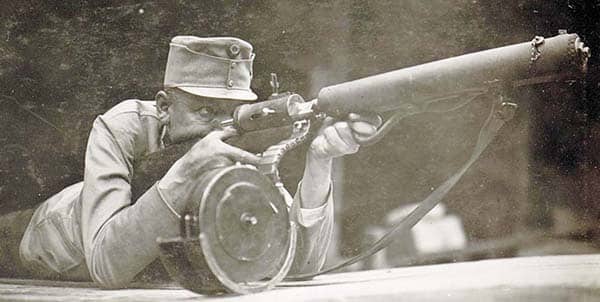By Tom Murphy
Wikipedia defines a submachine gun as: “a magazine-fed, automatic carbine designed to shoot handgun cartridges.” The term submachine gun was coined by John T. Thompson, the inventor of the Thompson submachine gun. In modern parlance, they’re frequently referred to as “subguns.”
Most subguns operate using the blowback action where the force and gasses of the fired shell drive the bolt back against a strong spring while ejecting the spent casing. As long as the trigger is held down, this action will repeat until the magazine goes dry. The most common calibers are 9mm and .45 ACP. The rate of fire can vary by gun, but 650 rounds per minute are easily attained. A subgun can empty a 50-round magazine in less than 5 seconds. Normally, a submachine gun is fired in short bursts of three to four rounds; they are primarily a short-range weapon, with shots kept under 50 yards.
The submachine gun was never intended to be a front-line weapon, but it worked well in close quarter battle (CQB) and under short-range assault conditions. The idea of a man-portable, full-auto weapon became popular with the militaries of the world toward the end of World War I. Up until then, fully automatic machine guns firing rifle cartridges were heavy (the Browning 1917, including tripod, gun, cooling water and ammo, weighed 103 pounds) and required a crew of up to four soldiers to operate and transport. One man could carry a submachine gun and enough ammunition to sustain him for a battle.
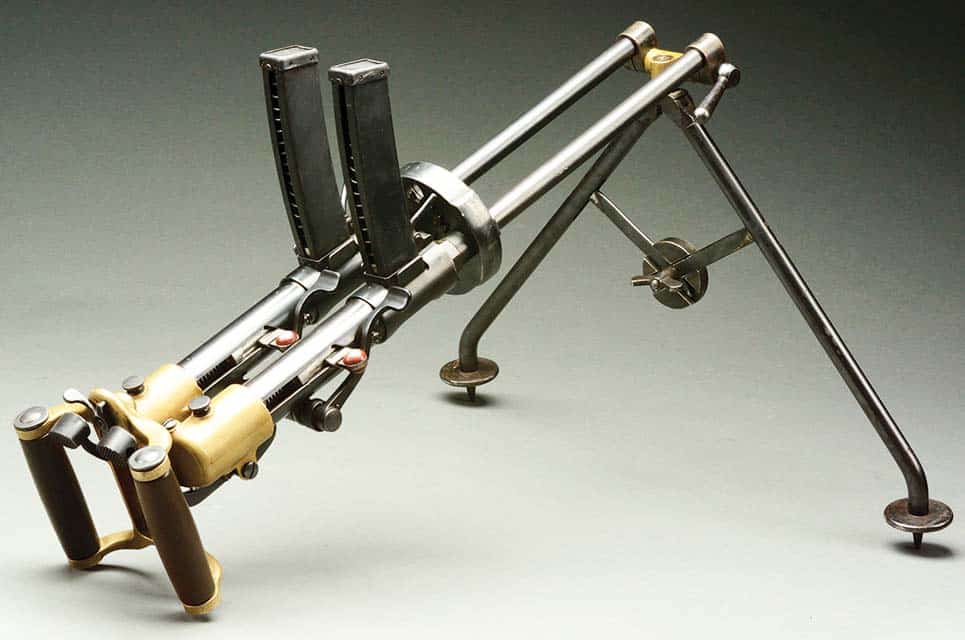
The First Submachine Guns
Standschütze Hellriegel
The Austro-Hungarian military force ordered a pistol-caliber, fully automatic weapon in 1915. The Standschütze Hellriegel submachine gun was the result. Not much is known about this weapon, and it appears not to have advanced past the prototype stage. It used a large drum magazine located under the receiver and connected to the action by means of a flexible chute. It could also accommodate box magazines. Its likely caliber was the 9x23mm Steyr that was originally designed for the Steyr M1912 pistol. Ballistics with a 115-grain bullet were 1,025 feet per second and 268 ft-lb of muzzle energy.
An unusual feature of the gun was its water-cooled barrel. A water jacket encased in leather was fitted over the barrel. Two ports allowed the jacket to be filled or drained.
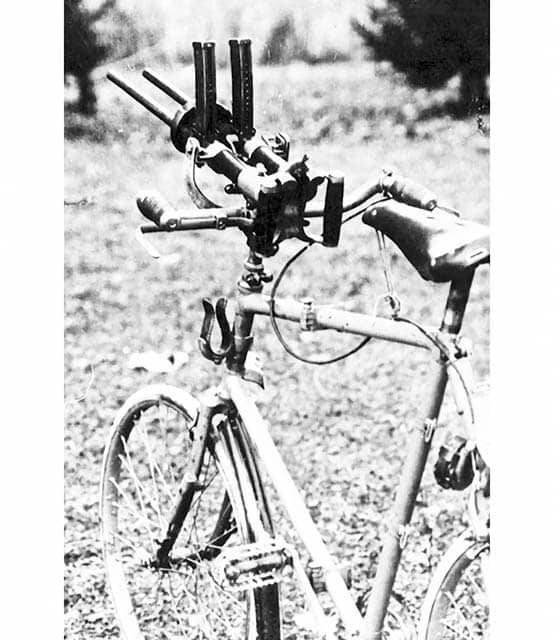
Villar Perosa
The first operational submachine gun was the Italian Villar Perosa Model 1915. First designed in in Italy in 1914 by designer Abiel Revelli, the creator of the Fiat-Revelli Modello 1914 machine gun, the Villar Perosa is a rare and unusual gun in that it is really two complete guns joined together by a bronze casting at the rear of the actions and a circular steel plate in front of the ejection ports. Both guns can be fired simultaneously, or each can be operated separately. The cartridges—9mm Glisenti—feed from dual 25-round magazines. With only a 100-grain bullet trundling along at 1,000 feet per second (if lucky) and 300 ft-lb of muzzle energy, it wasn’t too successful at hitting its intended targets—aircraft—but it worked satisfactorily as a ground attack weapon. A period black and white photo shows the Villar Perosa mounted on a bicycle’s handlebars, so it had to be fairly subdued when fired.
Normal operation consisted of firing one barrel at a time while an assistant gunner changed magazines on the other. One of its drawbacks was that it would empty a magazine in slightly over 1 second which made continuous rapid fire next to impossible. A fate of a lot of these subguns was being broken down to individual guns in 1918 and made into submachine guns by the addition of a forearm, buttstock and single trigger.
There’s a lot of room for funny comments about the care and operation of the Villar Perosa, but it was a reliable weapon for the time, and the one this author inspected was beautifully fabricated. One recently changed hands as an NFA weapon for $50,000+.
The Ubiquitous Thompson
There’s been millions of words written about John Thompson’s submachine gun and millions of rounds fired through them. John T. Thompson was born on the last day of 1860 in Newport, Kentucky. His father was a Lt. Col., and the family moved around a lot of Army posts. John followed in his father’s footsteps and trained in engineering and artillery and then was assigned to the Army Ordnance Department, Fort Lee, Virginia. He spent the balance of his military career there.
John Bell Blish, a career Navy officer and inventor, had developed a blowback action that used a friction delay method of controlling rate of fire. This became the well-known Blish lock. Thompson saw in the Blish Lock a method of developing a fully automatic submachine gun that would be an excellent weapon to use in sweeping trenches clean. This trench sweeper was chambered in the cartridge used in the Colt 1911 pistol—the .45 ACP. The range wasn’t great, but the heavy 230-grain full metal jacket (FMJ) bullet excelled in its trench sweeping duties. Unfortunately, the Thompson submachine gun didn’t come out of development until after the armistice was signed, ending WWI. The U.S. Army adopted the Thompson in 1928, and it saw action in World War II, Korea and Vietnam.
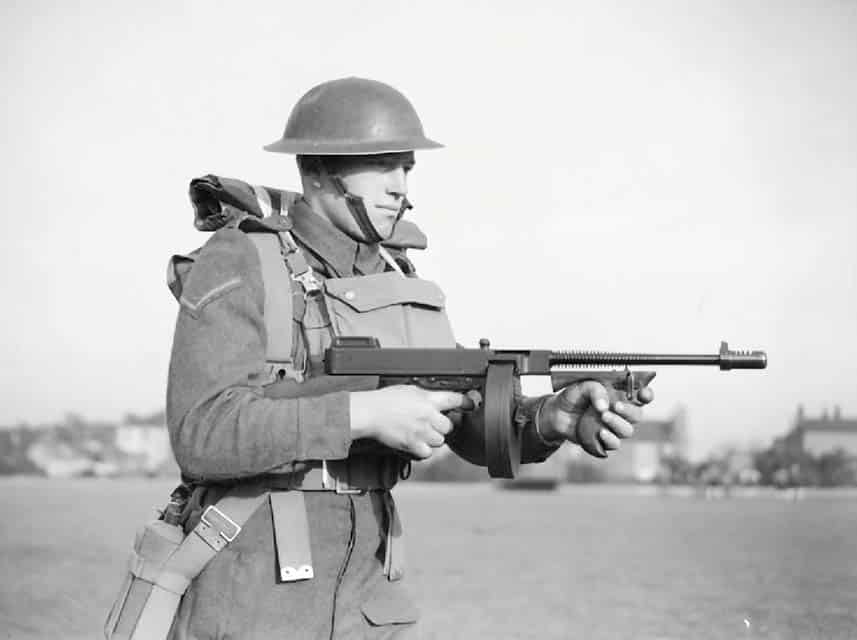
Variants
Annihilator, Persuader and Model 1919
The Persuader was a belt-fed prototype designed, but never finished in 1917. The Annihilator resembled the later models but had no provisions for a rear sight or buttstock. The Model 1919 laid down the final design for future models. Other prototypes were built, but none of them saw production.
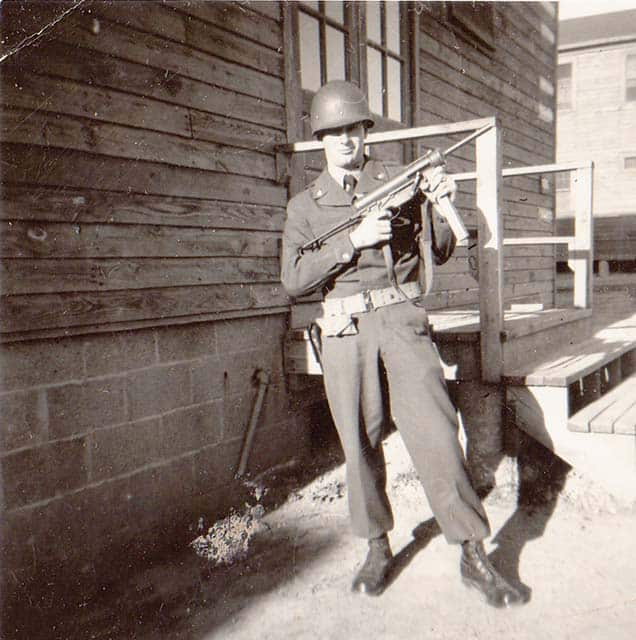
Production
Model 1921. This was the first model produced in volume. Over 15,000 were produced by Colt for Auto-Ordnance Corporation, an arms firm founded by John Thompson in 1916. The company’s purpose was to handle and develop the Thompson submachine gun. The Model 1921 was expensive to manufacture due to the amount of machining required on the receiver and Blish lock. Fitted with a high grade stock, it retailed for $200; a large sum in the early 1920s. Strangely enough, that’s the exact same amount of money the ATF charged for its U.S. National Firearms Act tax stamp in 1934 forward.
Model 1923. This was a heavy machine gun and was demonstrated for the Army. It was not adopted.
Model 1921 AC. This was an M1921 with a Cutts Compensator on the muzzle.
Model 1928. This gun was ordered by the U.S. military. The major users were the Navy and Marine Corps. Weight was added to the actuator to slow down the cyclic rate of fire which made the gun more controllable. This model had an “8” stamped over the last “1” on the model designation of the 1921. It was known as the “28 Navy,” or “1921 Overstamp.”

Model 1928A1. The distinct, vertical forward grip was changed to a plain horizontal one, and sling attachment points were installed. Over 562,500 were made. Wartime variants had a fixed rear sight, no ribs on the barrel, and most of them used a stick magazine in lieu of the heavier, rattling drum magazine.
Model M1. In 1942, the Thompson was re-engineered to be a more rugged, more serviceable weapon. The Blish lock was removed, the drum magazine latch and receiver grove disappeared, and the Cutts Compensator abandoned. The cocking handle was moved to the right side and the action converted to straight blowback. Late stocks were re-enforced with bolts and washers.
Model M1A. The major change from the M1 to the M1A was the transition from a floating firing pin to a pin machined directly onto the bolt face.
There are other versions of the Thompson, but they were all semiautomatic or never produced for sale.

The M3 Grease Gun
By 1945, the Thompson was replaced with the low-cost M3 “Grease Gun;” termed as such due to its striking resemblance to an automotive grease gun in use at the time. It fired the same round as the Thompson. Most of its major parts were made from cheap metal stampings. Adopted by the military at the end of 1942, it saw service up to and including the Syrian Civil War.
George Hyde, a German-born American machinist, was the chief gun designer for the Inland Division of General Motors. He oversaw the production of more than 700,000 M3 Grease Guns.
Its cyclic rate of fire is 700 rounds per minute, and it can empty a magazine in 7.5 seconds. It has no provision for semiauto fire. This helped keep costs down to a 1943, $15.00-level per unit. Guide Lamp division of General Motors produced 343,372 M3s in 1944 alone.
One of the more interesting of the various cost cutting measures employed over the M3’s production life was the ejection port cover/safety. It has a stud that engages the bolt when it’s for ward, stopping the bolt from moving backward when subjected to rough handling. As the M3 fires from an open bolt, this is very important. When the bolt is retracted the stud engages a recess on the bolt which stops it from firing. The cover has to be open for the gun to fire.
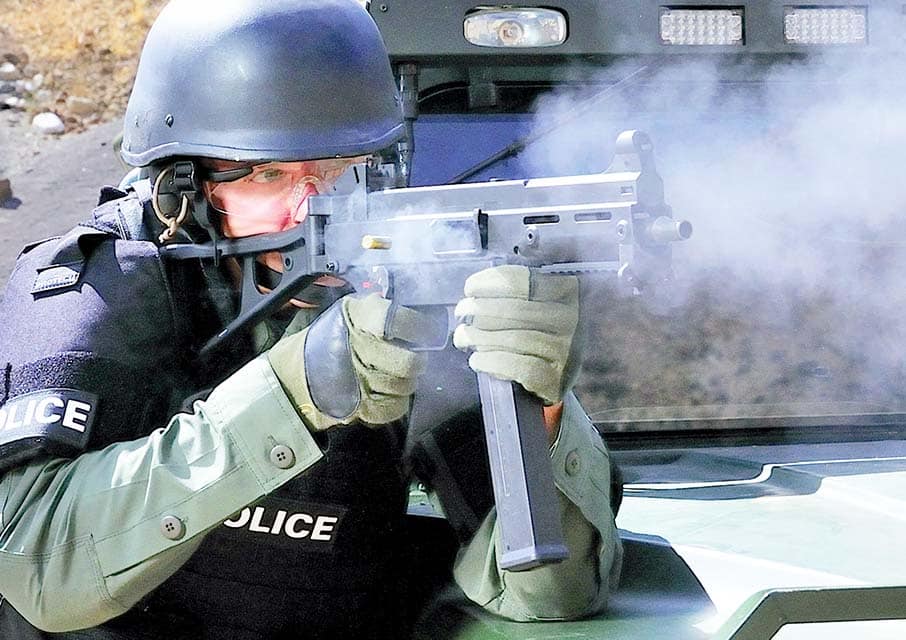
The HK UMP is a recent entry into the submachine gun market. It isn’t a replacement for the MP5, just a lower-cost, easier-produced weapon.
STEN Gun
Over 4 million STENs were produced in various types during the 1940s. (Depending on who is asked, the numbers run anywhere from 3.7 to 4.6 million.) It was a cheaply fabricated British weapon with most of its parts assembled from steel stampings in a similar manner as the American M3. It was a blowback action firing from an open bolt. The magazine was on the left side of the tubular receiver and carried 32 rounds of 9x19mm Parabellum.
There were seven variants of the STEN, with the latest version, the Mk VI, costing His Majesty’s government a huge $10 in 1942. Some of the cheapest models had only 47 parts. The cheap quality of the STEN, coupled with its rudimentary open bolt, made it prone to accidental discharges.
The STEN had a long life cycle. As late as 1994, the Zapatista Army of National Liberation operating in Chiapas, Mexico, still had some in circulation. Not bad for a $10 subgun.
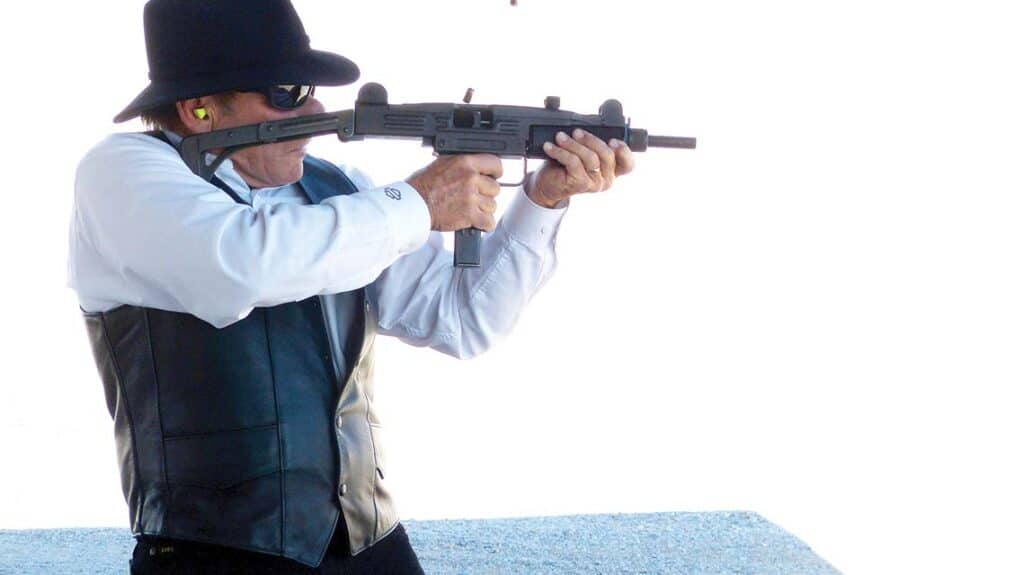
Post-WWII
Uzi
In the late 1940s, after Israel became a nation, an Israeli Army Lieutenant, Uziel Gal, designed a submachine gun for the Israel Defense Forces. Israel had just fought its Arab neighbors—Egypt, Syria, Lebanon and Transjordan (Jordan)—with a motley collection of foreign machine guns, rifles and submachine guns which proved to be a logistical disaster and alerted the need for an arms industry of its own.
Lt. Gal designed a short, compact weapon with a collapsible stock that fired from an open bolt. Similar to other types of submachine guns, the Uzi was constructed from metal stampings which reduced production costs and made it easy to manufacture. Rate of fire was a relatively slow 600 rounds per minute, and it could be loaded with either a 25- or 32-round magazine. The slow rate of fire made controlled-round bursts easier for recruits and conscripts to operate. Its low recoil 9mm cartridge aided in keeping rounds on target.
The Uzi’s first armed conflict took place in October 1956 when the 202nd Brigade of the Israeli Army, led by Ariel Sharon, captured Mitla Pass during the Suez War. The Uzi was subsequently employed against Jordanian and Syrian troops in further conflicts.
Various military variants of the Uzi have been produced.
Uzi submachine gun. This is the standard Uzi with a 10-inch barrel. It was manufactured in both 9mm and .45 ACP. The .45ACP model has a sustained rate of fire of 500 rounds per minute.
Mini Uzi. This is a smaller version of the standard Uzi, introduced in 1980. Overall length with the stock extended is 23.6 inches. Due to its smaller bolt, the rate of fire is increased to 950 rounds per minute.
Micro Uzi. First shown in 1986, it fires from a closed bolt and weighs just 3.3 pounds.
The Uzi Pro. This is a much modified Uzi that uses polymer in its non-stressed parts. Its future is uncertain.
| This article first appeared in Small Arms Review V24N3 (March 2020) |



